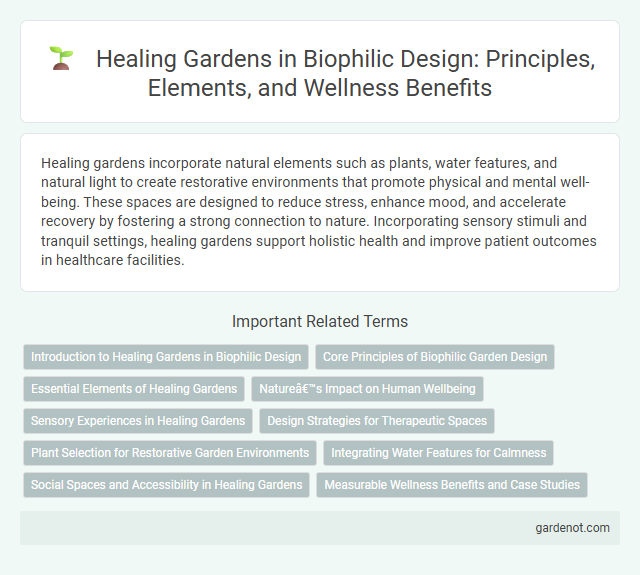Healing gardens incorporate natural elements such as plants, water features, and natural light to create restorative environments that promote physical and mental well-being. These spaces are designed to reduce stress, enhance mood, and accelerate recovery by fostering a strong connection to nature. Incorporating sensory stimuli and tranquil settings, healing gardens support holistic health and improve patient outcomes in healthcare facilities.
Introduction to Healing Gardens in Biophilic Design
Healing gardens in biophilic design integrate natural elements such as plants, water features, and natural light to promote physical and psychological recovery. These gardens create restorative environments that reduce stress, enhance mood, and improve cognitive function by fostering a connection to nature. Incorporating healing gardens into healthcare facilities and residential spaces supports well-being by aligning design with innate human affinities for natural settings.
Core Principles of Biophilic Garden Design
Healing gardens in biophilic design prioritize natural elements like native plants, water features, and natural light to promote well-being and stress reduction. Emphasis on sensory engagement through textures, scents, and colors enhances connection to nature, fostering restoration and mental clarity. Spatial variation and accessibility ensure inclusive, adaptable environments that support physical and emotional healing.
Essential Elements of Healing Gardens
Healing gardens integrate essential elements such as water features, which promote relaxation through soothing sounds, and diverse plant species that enhance sensory stimulation and biodiversity. Comfortable seating and shaded areas encourage prolonged engagement with nature, supporting mental restoration and stress reduction. Pathways and natural materials guide movement, fostering physical activity and a deep connection to the environment.
Nature’s Impact on Human Wellbeing
Healing gardens harness biophilic design principles by integrating natural elements such as plants, water features, and natural light to enhance mental and physical wellbeing. Exposure to these environments reduces stress, lowers blood pressure, and accelerates recovery times in healthcare settings. Studies show that patients with views of greenery or access to healing gardens experience decreased anxiety and improved mood, reinforcing nature's critical role in promoting holistic health.
Sensory Experiences in Healing Gardens
Healing gardens stimulate multiple sensory experiences through the integration of natural elements such as fragrant plants, textured surfaces, and soothing water features. Visual stimuli are enhanced by vibrant flowers and diverse foliage, promoting relaxation and reducing stress hormones like cortisol. Auditory elements, including bird songs and flowing water, engage patients' senses to improve mood and cognitive function in therapeutic settings.
Design Strategies for Therapeutic Spaces
Healing gardens in biophilic design incorporate natural elements such as native plants, water features, and natural light to create calming and restorative environments. Design strategies emphasize sensory engagement, privacy, and accessibility, promoting physical and psychological well-being for patients and caregivers. Incorporating pathways, seating areas, and views of nature enhances therapeutic benefits by reducing stress and supporting recovery.
Plant Selection for Restorative Garden Environments
Healing gardens prioritize plant selection that enhances restorative benefits by incorporating native species known for calming effects and seasonal interest. Plants with varied textures, colors, and scents, such as lavender, chamomile, and ornamental grasses, support sensory engagement and stress reduction. Incorporating drought-tolerant and low-maintenance plants ensures sustainability and long-term vitality of restorative garden environments.
Integrating Water Features for Calmness
Integrating water features in healing gardens enhances biophilic design by promoting tranquility and reducing stress through the soothing sounds of flowing water. Strategic placement of fountains, streams, or ponds supports natural relaxation responses, contributing to improved mental well-being and faster recovery in healthcare settings. Studies show that water elements can lower cortisol levels and create a sensory-rich environment that fosters calmness and emotional balance.
Social Spaces and Accessibility in Healing Gardens
Healing gardens enhance patient recovery by integrating accessible social spaces that promote interaction and community support. Inclusive design features such as wide pathways, seating areas, and sensory elements accommodate diverse mobility needs, ensuring all users can benefit from nature's therapeutic effects. These accessible social environments foster emotional well-being and reduce stress, contributing to holistic health outcomes in healthcare settings.
Measurable Wellness Benefits and Case Studies
Healing gardens in biophilic design demonstrate measurable wellness benefits by reducing stress, improving mood, and enhancing cognitive function in various healthcare settings. Case studies from hospitals such as the Cleveland Clinic and the University of Michigan reveal significant decreases in patient recovery times and lower use of pain medication linked to garden interaction. These environments support physiological improvements including lowered blood pressure and heart rate, validating the therapeutic impact of natural landscapes within clinical care.
Healing garden Infographic

 gardenot.com
gardenot.com